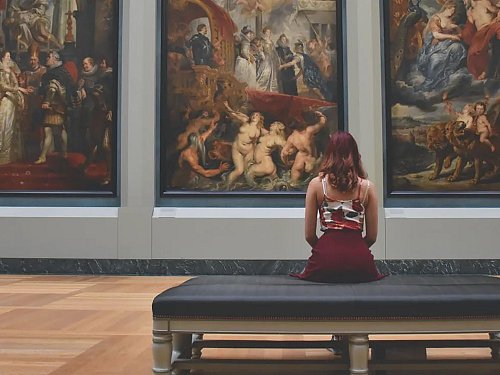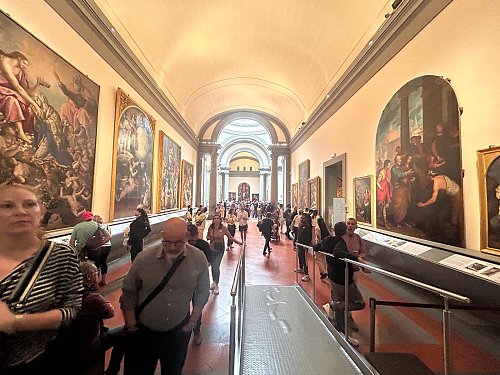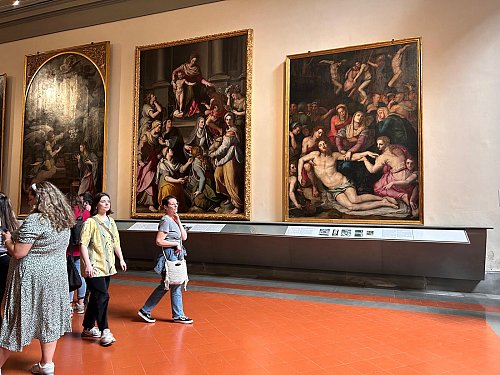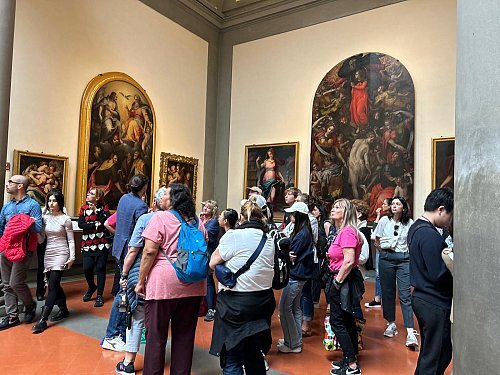O Tribuno

Na década de 1850, iniciou-se um acalorado debate sobre a preservação do David de mármore de Michelangelo, de 1504, que ficaria na Piazza della Signoria. O arquiteto Emilio de Fabris foi encarregado de projetar uma tribuna quadrangular na parte inferior do que hoje é conhecido como “Galeria das pinturas antigas”, onde se alinha com o atual Salão dos Prisioneiros. Estava previsto que o David de Michelangelo fosse colocado no centro desta tribuna, sob uma claraboia muito luminosa com a forma de uma cúpula circular, em 1873. Em agosto desse ano, a estátua foi desmontada (em uma estrutura de madeira especialmente construída para esse fim) e removida sobre trilhos em direção à Accademia. No entanto, quando chegaram à Accademia, não foi possível colocá-la dentro do prédio porque... A Tribuna ainda não estava concluída! Documentos de arquivo mostram que a estátua ficou na carroça de madeira do lado de fora até 1882, quando a Tribuna foi concluída e aberta ao público. Isso significa que o David passou um total de 9 anos em sua caixa!
Inicialmente, as alas da Tribuna exibiam cópias das obras-primas do próprio Michelangelo e, depois, tondos. Agora podemos apreciar o David com essas outras obras pertencentes a outros artistas do século XVI, como Bronzino, Cecchino Salviati e Allori, nessas duas alas da Tribuna. A escolha desses artistas em particular serve para destacar de forma proeminente a forma como eles estavam ligados a Michelangelo durante sua vida, suas obras e a influência cultural que suas obras tiveram sobre eles.

Homenagem à direita
É isso que tentamos fazer neste relatório com a obra de Francesco Salviati, Madonna e Menino com o jovem São João e um anjo à direita de Davi. Salviati foi aprendiz de Andrea del Sarto e teve uma longa e animada carreira que o levou não apenas por Florença e Roma, mas também pela França, antes de trabalhar para a corte internacional do maneirismo em Fontainebleau.
Madonna e Menino, com os tons iridescentes característicos dos artistas maneiristas, ganharam luminosidade aqui; as tonalidades foram retocadas em 2003, mas ficaram muito fortes após a restauração.
A conexão que Francesco Salviati tinha com Michelangelo não era apenas em termos de empregar poses dinâmicas e torções exageradas em suas figuras, mas também porque ele ajudou a preservar os pedaços de mármore do braço de Davi depois que a estátua foi danificada durante um motim na Piazza della Signoria. Em 1527, dois homens se lançaram sobre os fragmentos, Francesco Salviati e Giorgio Vasari, e há cerca de doze anos Davi foi restaurado.

Homenagem à esquerda
Depois de virar à esquerda após o David, várias obras de arte se alinham no corredor e merecem uma parada para serem apreciadas.
À esquerda, você se depara pela primeira vez com a obra “Deposição de Cristo”, de Santi di Tito (óleo sobre painel, c. 1590). Este grande painel retrata uma deposição, com as cruzes do Gólgota emergindo proeminentemente contra um céu tranquilo ao fundo e parecendo emoldurar o espaço em primeiro plano para o lamento. O corpo de Cristo, quase totalmente deitado no chão, é sustentado pela Virgem, com São João Batista de um lado e Santa Catarina de Alexandria junto com o doador, que está vestido com uma armadura fina marcada com os sinais da Ordem dos Cavaleiros de Santo Estêvão. Ele é conhecido como Ernando Sastri, da Espanha, cujo brasão aparece no escudo no canto inferior direito, que recebeu essa honra em 1576. A pintura captura um clima de profunda introspecção e reflexão, enquanto o cavaleiro, colocado em primeiro plano com a mão esquerda estendida para fora, conecta a imagem aos espectadores — atraindo-os, neste caso, para a meditação e incentivando seu envolvimento emocional. Antes da restauração em 2003, uma pesada camada de tinta havia obscurecido grande parte da paisagem de fundo, ocultando o céu e as cruzes, impedindo a percepção do espaço e sua relação com o que o rodeia. A parte inferior esquerda do painel apresenta a assinatura de Santi di Tito.

À direita, havia um grande painel da obra “A Deposição de Cristo”, de Bronzino. Foi encomendada por Cosme I, duque da Toscana, para uma igreja em Portoferraio, localizada na ilha de Elba, próxima à costa da Toscana. Por ser um painel de grandes dimensões, a obra foi transportada por navio: primeiro pelo rio Arno até o porto de Pisa e, em seguida, por mar aberto até seu destino final. Em 1561, Bronzino e seu assistente Alessandro Allori concluíram o trabalho na pintura.
Sua assinatura está localizada em um vaso verde proeminente no canto inferior esquerdo da pintura. A composição é orientada de cima para baixo, retratando o momento da descida de Cristo da cruz; ela guia o espectador através de formas sinuosas e eloquentes em direção àqueles que lamentam no centro do foco. O corpo nu e pálido de Cristo e sua intensidade escultural, com o torso intricadamente modelado, são áreas em que a mão de Bronzino foi influenciada por Michelangelo.
Uma limpeza feita em 2003 removeu da obra de arte importantes camadas de repinturas pesadas que obscureciam a superfície original. Antes da restauração, a cidade fortificada ao fundo, sobre a Colina do Gólgota, no canto superior esquerdo, não era visível. Portoferraio poderia estar retratada aqui, com três fortes bastiões construídos sob Cosme I para defender contra invasões de piratas. A figura barbuda na extrema esquerda, olhando para fora, foi identificada como um autorretrato do próprio Bronzino. Continue lendo para uma nota interessante sobre o recente processo de restauração desta pintura.

A terceira da direita é a Anunciação de Allori, pintada por Alessandro Allori a óleo sobre madeira por volta de 1572-1578. O convento de Montedomini encomendou o grande painel para a irmã Laura dei Pazzi, representando a típica Anunciação florentina do século XVI, com a modéstia característica da época. A composição mostra Gabriel ajoelhado numa nuvem, anunciando à Virgem que ela será a mãe de Cristo. Ele oferece a Maria um lírio branco (Lilium candidum) como símbolo de pureza com a mão direita e aponta para o Espírito Santo descendo do céu com a esquerda. Mais acima, anjos espalham várias flores do alto. Um detalhe adicional é dado pela presença atraente de uma cesta de costura, e os detalhes minuciosos do bordado inserido na frente de um anjo chamam a atenção.
Nesta amostra de texto reescrito, você notará um uso mais sofisticado da linguagem, juntamente com um aumento no comprimento e na complexidade das frases em comparação com o conteúdo geral gerado por IA, mas não tão refinado quanto a produção de nível humano.
A quarta obra é de Alessandro Allori e intitula-se A Coroação da Virgem (óleo sobre tela, 1593). Com esta pintura, o artista prestou uma homenagem com flores muito ornamentais, frescas, com tons variados e subtis na sua escala de valores — em suma, um fundo ideal e alegre para um tema como a Coroação da Virgem. Foi encomendada a Allori para a Igreja de Santa Mônica, em Florença.
Convidando-nos para o Paraíso, brilhante com cores e elegância, há uma variedade de plantas floridas aqui representadas por inúmeras espécies de cada tipo de planta conhecida pelo homem; elas revelam seu significado místico enquanto exalam sua fragrância diante daqueles que as contemplam. Quando visões impulsionaram os artistas a criar flores como símbolos durante a Idade Média, detalhes precisos eram desconhecidos; portanto, essas pinturas só podiam ser concluídas por meio da inspiração divina, e não da observação. O apoio da família Medici à ciência acabou por estimular esta arte botânica: despertou o interesse pelos temas florais entre os pintores que procuravam retratar a natureza de forma realista e precisavam de imagens botânicas corretas.
